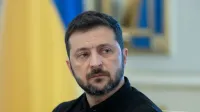Ukrainian Navy strikes Russian oil rig with AI-enhanced sea drones in Black Sea operation
global.espreso.tv
Tue, 04 Nov 2025 14:53:00 +0200

Defense Express reported the information.The Ukrainian Navy released footage of the nighttime strike on the self-elevating drilling platform Syvash, which took place in the early hours of November 2nd. According to naval officials, the attack successfully hit an elite Russian special forces unit positioned on the platform, destroying an anti-tank guided missile system—likely a 9K135 Kornet—along with reconnaissance and surveillance equipment.While the Navy declined to specify which exact drone models were deployed, video footage reveals the use of both 'kamikaze' drones and carrier vessels equipped with FPV (first-person view) drones. The footage notably shows what appears to be artificial intelligence software automatically acquiring the drilling platform as a target and identifying optimal strike points on its support structures.Defense analysts suggest three possible drone types could have been involved in the operation. The first candidate is the Barracuda series, particularly the Barracuda 9 variant developed by Ukraine's 40th Separate Naval Infantry Brigade. This theory gains credibility from the fact that the Barracuda family is known to incorporate AI capabilities, and the drones share similar nose configurations visible in the attack footage.Another possibility is a variant of the Sea Baby drone, developed by Ukraine's Security Service. Evidence supporting this theory includes structural similarities in both vessels, particularly an elevated section around the engine area with side-mounted radiators or ventilation systems. These features create distinctive heat signatures visible on thermal imaging. Both designs feature comparable superstructures with small radar systems, antennas, and similar placement of FPV drone storage compartments and satellite communication equipment.The third option involves an as-yet-unnamed Ukrainian sea drone that may have been used in a similar attack on gas platforms in December 2024. Naval analyst H.I. Sutton previously suggested that operation involved a new type of unmanned surface vessel, and the general design characteristics—including the raised engine section and hull shape—appear consistent with the drones seen in this latest strike.It's worth noting that given the secrecy surrounding the Barracuda variants and the unnamed drone type, these could potentially be related or even part of the same family of vessels.Russian sources have provided conflicting accounts of the attack. Some reports claim six drones attacked from one direction, while others state nine drones approached from two sides. Russian military channels assert that only one drone reached its target, with the others either retreating or being destroyed by Lancet loitering munitions and Kornet missiles. However, Ukrainian footage clearly shows at least two kamikaze drones successfully striking the platform, and the vessels that withdrew may have been reusable FPV carrier drones returning to base after expending their munitions.The attack represents another demonstration of Ukraine's growing capabilities in unmanned naval warfare, particularly the integration of artificial intelligence for precision targeting in maritime operations.








